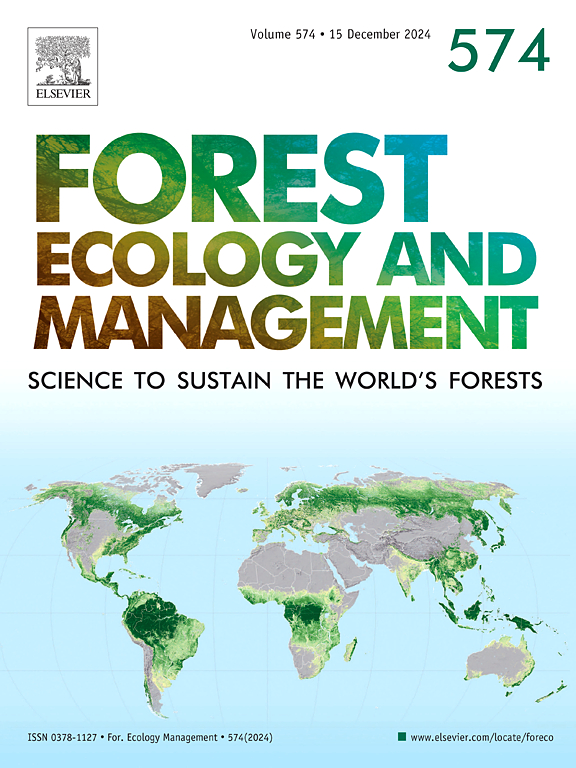林木活力定义:松木和栎树落叶、生长和水分利用效率对干旱的不同响应
IF 3.7
2区 农林科学
Q1 FORESTRY
引用次数: 0
摘要
需要改进树木活力的定义来描述森林对干旱的适应能力。我们根据年冠脱落量和径向生长数据建立了活力指数。该指数应用于Doñana国家公园(西班牙西南部)中受死亡影响的石松(Pinus pinea)和栓皮栎(Quercus suber)树木,比较干燥和潮湿的地点。气候数据与落叶、生长和活力指数相关。还研究了从phenocams(2018年 −2024年)获得的覆盖物绿度(gcc,绿色色坐标)的日测量值,以及从树木计(2024年生长季节)获得的茎径向生长和树木水分亏缺的变化。最后,我们使用δ13C木材数据来回顾性评估内在水利用效率(iWUE)。在2024年期间,松树的年轮生长大于橡树(2.0 vs. 0.5 mm),但橡树年轮(4.34 mm)比松树年轮(2.50 mm)宽。树木水分亏缺在橡树中较高。在干地,gcc与石松水分亏缺呈负相关,而在湿地,gcc与栓皮栎生长速率呈正相关。栓皮栎的年落叶率(26 %)高于松树(22 %)。2005年和2012年干旱后,石松和栓皮栎的落叶量均有所增加,而基面积增长量则有所减少。石松活力指数呈下降趋势。冬春季干燥温暖的条件和土壤湿度低会增加落叶,减少生长。栓皮栎和石松分别在落叶和生长方面对干旱的响应更大。石松的iWUE在2016年之后急剧增加,而橡树的iWUE在最近才增加。未来的研究可以利用更长的时间序列的多种树种的落叶和生长数据来完善活力指数。本文章由计算机程序翻译,如有差异,请以英文原文为准。
Towards a tree vigor definition: Different responses of defoliation, growth and water-use efficiency to drought in pine and oak species
An improved definition of tree vigor is required to characterize forest resilience in response to drought. We developed a vigor index based on annual crown defoliation and radial-growth data. The index was applied to stone pine (Pinus pinea) and cork oak (Quercus suber) trees affected by die-off in the Doñana National Park (SW Spain), comparing a dry and a wet site. Climate data were correlated with defoliation, growth and the vigor index. Daily measures of cover greenness (gcc, green chromatic coordinate), obtained from phenocams (period 2018 −2024), and changes in stem radial growth and tree water deficit, obtained from dendrometers (2024 growing season), were also investigated. Finally, we used δ13C wood data to retrospectively assess intrinsic water-use efficiency (iWUE). During 2024, pines grew more than oaks on a yearly basis according to dendrometer data (2.0 vs. 0.5 mm), but annual tree rings were wider in oaks (4.34 mm) than in pines (2.50 mm). Tree water deficit was higher in oaks. In the dry site, gcc and stone pine water deficit were negatively associated, whereas in the wet site gcc and the cork oak growth rate were positively associated. Cork oak showed higher annual defoliation (26 %) than the pine (22 %). Defoliation increased in both species, whilst basal area increment decreased after the 2005 and 2012 droughts in stone pine and cork oak, respectively. The vigor index declined in the stone pine. Dry and warm winter-to-spring conditions and low soil moisture levels increased defoliation and reduced growth. Cork oak and stone pine responded more to drought in terms of defoliation and growth, respectively. The stone pine showed a sharp increase of iWUE after 2016, but the oak presented a more recent iWUE enhancement. Future research can refine the vigor index using longer time series of defoliation and growth data from multiple tree species.
求助全文
通过发布文献求助,成功后即可免费获取论文全文。
去求助
来源期刊

Forest Ecology and Management
农林科学-林学
CiteScore
7.50
自引率
10.80%
发文量
665
审稿时长
39 days
期刊介绍:
Forest Ecology and Management publishes scientific articles linking forest ecology with forest management, focusing on the application of biological, ecological and social knowledge to the management and conservation of plantations and natural forests. The scope of the journal includes all forest ecosystems of the world.
A peer-review process ensures the quality and international interest of the manuscripts accepted for publication. The journal encourages communication between scientists in disparate fields who share a common interest in ecology and forest management, bridging the gap between research workers and forest managers.
We encourage submission of papers that will have the strongest interest and value to the Journal''s international readership. Some key features of papers with strong interest include:
1. Clear connections between the ecology and management of forests;
2. Novel ideas or approaches to important challenges in forest ecology and management;
3. Studies that address a population of interest beyond the scale of single research sites, Three key points in the design of forest experiments, Forest Ecology and Management 255 (2008) 2022-2023);
4. Review Articles on timely, important topics. Authors are welcome to contact one of the editors to discuss the suitability of a potential review manuscript.
The Journal encourages proposals for special issues examining important areas of forest ecology and management. Potential guest editors should contact any of the Editors to begin discussions about topics, potential papers, and other details.
 求助内容:
求助内容: 应助结果提醒方式:
应助结果提醒方式:


